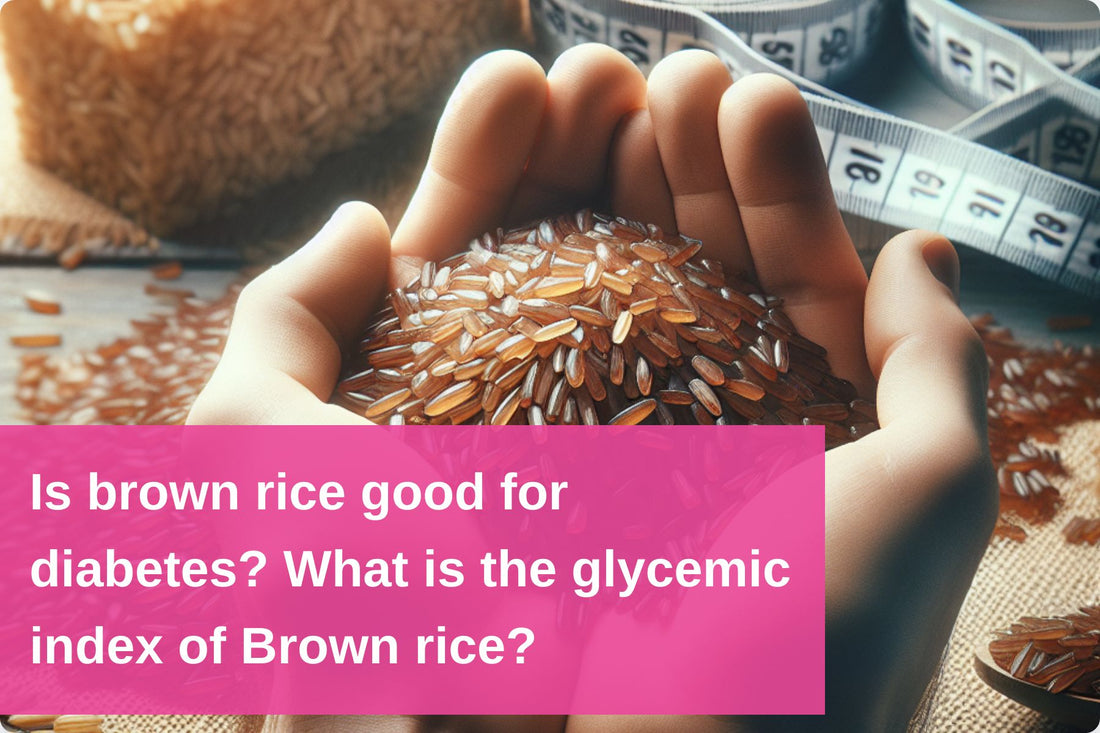In the world of handling diabetes, it's really important to talk about how the food we choose affects our health. What we eat directly affects how much sugar is in our blood, and that matters a lot in the daily fight against diabetes. Today, let's focus on a specific type of grain that people are talking about for its possible benefits in managing diabetes – brown rice.
For folks with diabetes trying to figure out what to eat, it's key to understand how each food component plays a role. Brown rice stands out because of its unique nutrition, and it could be a helpful friend in the journey to keep blood sugar levels steady. So, why is this simple grain getting attention, and how can it be a good thing for those dealing with diabetes? Let's dive into the details and find out the important aspects of having brown rice in our diet.
Understanding Diabetes and Dietary Choices
Living with diabetes involves making daily dietary choices that play a crucial role in managing the condition effectively. Every meal and snack must be considered in the context of how it will affect blood sugar levels, making nutrition an integral part of diabetes care.
The key is to maintain stable blood sugar levels by understanding the impact of different foods on the body. Foods with high glycemic indexes can cause rapid spikes in blood sugar, whereas those with low glycemic indexes result in more gradual increases.
Focus on complex carbohydrates (like whole grains and vegetables), lean proteins (such as chicken and fish), and healthy fats (like avocados and nuts) to regulate blood sugar and minimize spikes. These nutrient-dense foods are digested more slowly, leading to steadier blood sugar levels and providing sustained energy.
Portion Control: It's essential to practice portion control and mindful eating to prevent sudden spikes or crashes in blood sugar levels. Eating smaller, more frequent meals can help keep blood sugar levels consistent throughout the day. Measuring portions and being aware of serving sizes can help avoid overeating.
Informed Choices: Making informed food decisions, such as incorporating brown rice, can positively influence the balance of insulin and blood sugar, enhancing overall diabetes management. Brown rice, for example, has a lower glycemic index than white rice, providing more fiber and nutrients that aid in blood sugar control.
The Benefits of Brown Rice for Diabetes
Nutrient-Rich Composition: Brown rice retains its bran and germ layers, unlike white rice which is stripped of these parts during processing. This makes brown rice a nutrient-dense option, providing more vitamins, minerals, and antioxidants essential for overall health. These nutrients can support better diabetes management by improving overall body functions and metabolic processes.
High Fiber Content: The fiber in brown rice plays a critical role in diabetes management by slowing the digestion and absorption of carbohydrates. This leads to a more gradual rise in blood sugar levels, helping to prevent the sudden spikes and drops that can be challenging for individuals with diabetes to manage. Additionally, fiber supports digestive health and helps maintain regular bowel movements.
Essential Vitamins and Minerals: Brown rice is a good source of B vitamins such as niacin (B3) and pyridoxine (B6), which are important for energy production and the proper functioning of the nervous system. It also contains minerals like magnesium and phosphorus. Magnesium is crucial for over 300 enzymatic reactions in the body, including those involved in glucose metabolism and insulin action, while phosphorus is important for bone health and energy metabolism.
Satiety and Weight Management: The high fiber content in brown rice promotes a feeling of fullness and satiety, which can help with weight management. Maintaining a healthy weight is important for managing diabetes, as excess weight can worsen insulin resistance and blood sugar control. By helping to control appetite and reduce overall calorie intake, brown rice can be a beneficial part of a weight management strategy.
Strategic Dietary Component: Incorporating brown rice into the diet provides more than just immediate nutritional benefits. It contributes to long-term health by supporting better blood sugar control, enhancing nutrient intake, and aiding in weight management. This makes brown rice a strategic component of a diabetes-friendly diet, helping to balance blood sugar levels, improve metabolic health, and reduce the risk of diabetes-related complications.
Glycemic Index of Brown Rice
Understanding the glycemic index (GI) is pivotal in managing diabetes, as it measures how quickly a food item can raise blood sugar levels. Brown rice, with its distinct composition, holds a favourable position on the glycemic index scale, boasting a GI of 50.
Type of Rice |
Glycemic Index (GI) |
|---|---|
Brown Rice |
50 - 55 |
White Rice |
70 - 75 |
Red Rice |
55 - 65 |
Basmati Rice |
50 - 58 |
Jasmine Rice |
68 - 80 |
Wild Rice |
45 - 53 |
The GI of brown rice is classified as medium, meaning it has a slower impact on blood sugar compared to high-GI foods. This is attributed to the presence of fibre, which slows down the digestion and absorption of carbohydrates. For individuals with diabetes, opting for low to medium-GI foods is often recommended to prevent rapid spikes in blood sugar levels.
Brown rice's GI of 50 makes it an excellent choice for those seeking to manage their blood sugar effectively. This favourable score is indicative of the gradual and steady release of glucose into the bloodstream, offering sustained energy without causing abrupt fluctuations in blood sugar levels.
Comparing brown rice to its refined counterpart or other grains, the advantage becomes evident. White rice, having undergone extensive processing, has a higher GI, potentially leading to a more rapid increase in blood sugar levels. This stark difference highlights the significance of choosing whole grains, like brown rice, for those aiming to manage their blood sugar effectively.
Considering the impact of the glycemic index is not just about individual food choices; it's a strategic approach to crafting a diabetes-friendly diet. By opting for foods with a lower GI, like brown rice, individuals can potentially achieve better blood sugar control and contribute to their overall well-being.
Nutritional Composition of Brown Rice
Here's nutritional value of brown rice per 100 grams:
Nutrient |
Amount per 100 grams |
% Daily Value* |
Calories |
111 |
- |
Total Fat |
0.9 g |
1% |
Saturated Fat |
0.2 g |
1% |
Cholesterol |
0 mg |
0% |
Sodium |
5 mg |
0% |
Potassium |
43 mg |
1% |
Total Carbohydrate |
23 g |
7% |
Dietary Fibre |
1.8 g |
7% |
Granulated Sugar |
0.4 g |
- |
Protein |
2.6 g |
5% |
Can Brown Rice be Safely Included in a Diabetes Diet?
Manage portion sizes of brown rice to control carbohydrate intake, keeping blood sugar levels stable. Finding the right balance based on individual nutritional needs is crucial for effective diabetes management.
Use methods like steaming or boiling to cook brown rice, which helps retain its nutritional content and avoids adding unhealthy fats. This ensures brown rice remains beneficial for diabetes management.
Incorporate brown rice strategically into meals to create a balanced diet. Pair it with lean proteins, vegetables, and healthy fats to ensure a wholesome plate that adheres to diabetes-friendly eating guidelines.
Utilize brown rice in various recipes such as side dishes, salads, and stir-fries. Its nutty flavor and chewy texture make it a versatile ingredient that can enhance many different meals.
By following these tips, individuals with diabetes can enjoy the benefits of brown rice while making confident and healthy dietary choices. This includes portion control, healthy cooking methods, thoughtful meal planning, and creative culinary use.
Brown rice, the perfect choice for diabetics
In conclusion, the journey through the intricate relationship between diabetes and diet has illuminated the potential benefits of including brown rice in the culinary arsenal of individuals managing this condition. The nutritional richness of brown rice, with its fibre, vitamins, and minerals, positions it as a valuable addition to a diabetes-friendly diet.
The medium glycemic index of brown rice, in contrast to its refined counterparts, underscores its suitability for those seeking better blood sugar control. It's not just about the numbers on the glycemic index scale; it's about making informed choices that align with the principles of diabetes management.
When contemplating the inclusion of brown rice, practical considerations come to the forefront. Portion control, mindful cooking methods, and strategic meal planning are key elements in optimising the benefits of brown rice without compromising health. It's about crafting a balanced plate that contributes to stable blood sugar levels while offering a satisfying and flavorful dining experience.
As we navigate the nuanced landscape of diabetes and dietary choices, embracing the potential advantages of brown rice becomes a proactive step toward holistic well-being. However, it's crucial to remember that dietary decisions are personal and should be tailored to individual health conditions.
In urging informed choices, we encourage individuals to consult with healthcare professionals and dietitians. The journey towards managing diabetes is unique for each person, and by making thoughtful decisions based on reliable information, one can navigate this path with confidence and resilience. Ultimately, the inclusion of brown rice can be a flavorful and nutritious ally in the pursuit of a balanced and diabetes-friendly lifestyle.
This Blog post is an initiative by DiabeSmart, to provide accurate and Nutritionist / Doctor approved information related to Diabetes. DiabeSmart is India's first Food brand designed specifically for Diabetics, that has been clinically tested on Diabetics and Pre-Diabetics to deliver 55% - 70% lower Sugar spikes. DiabeSmart is part of Lo! Foods - India's leading brand for Everyday Functional Health foods.















